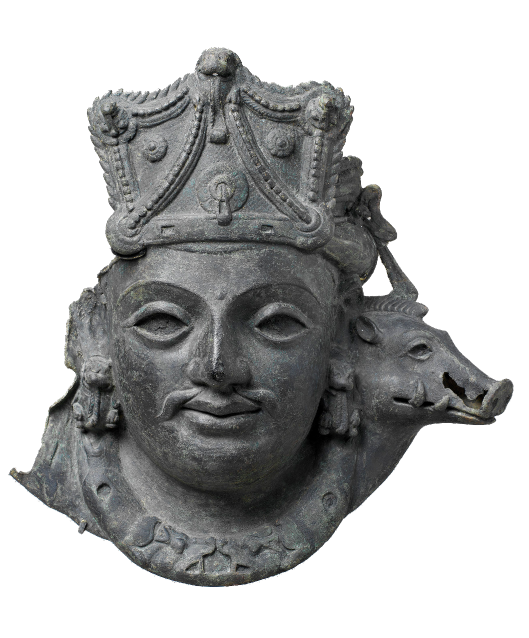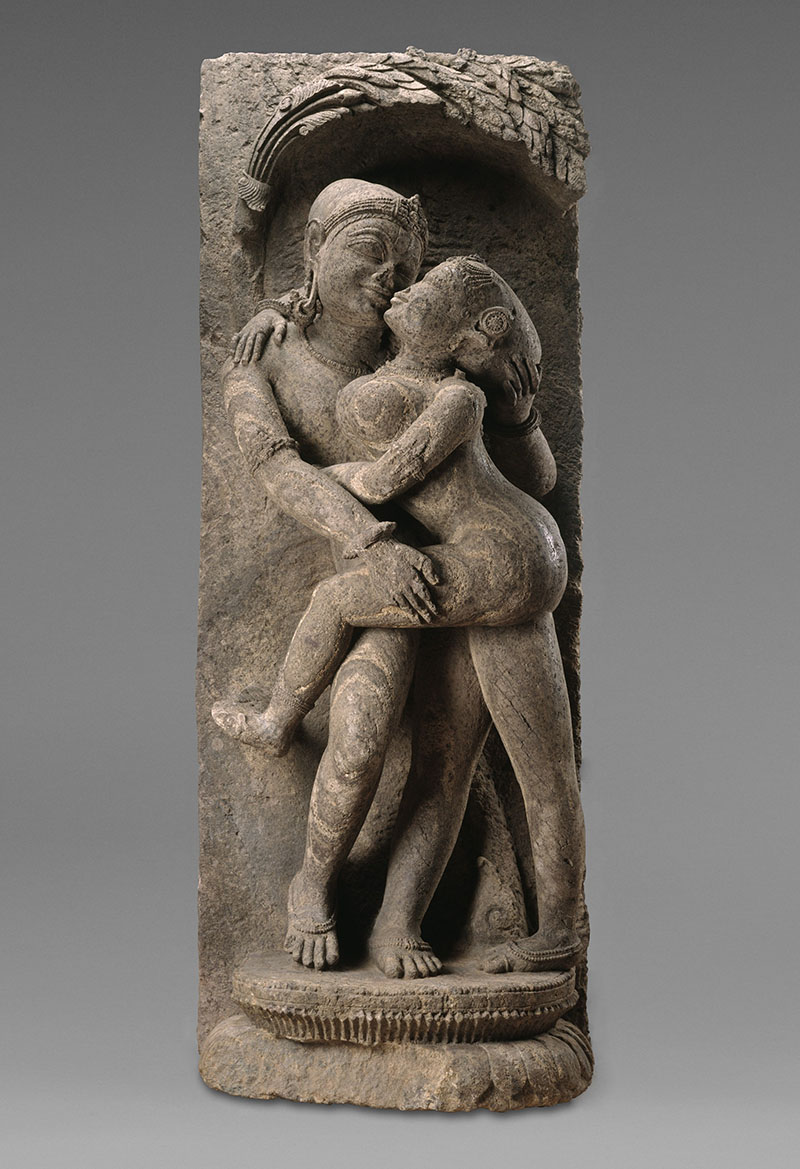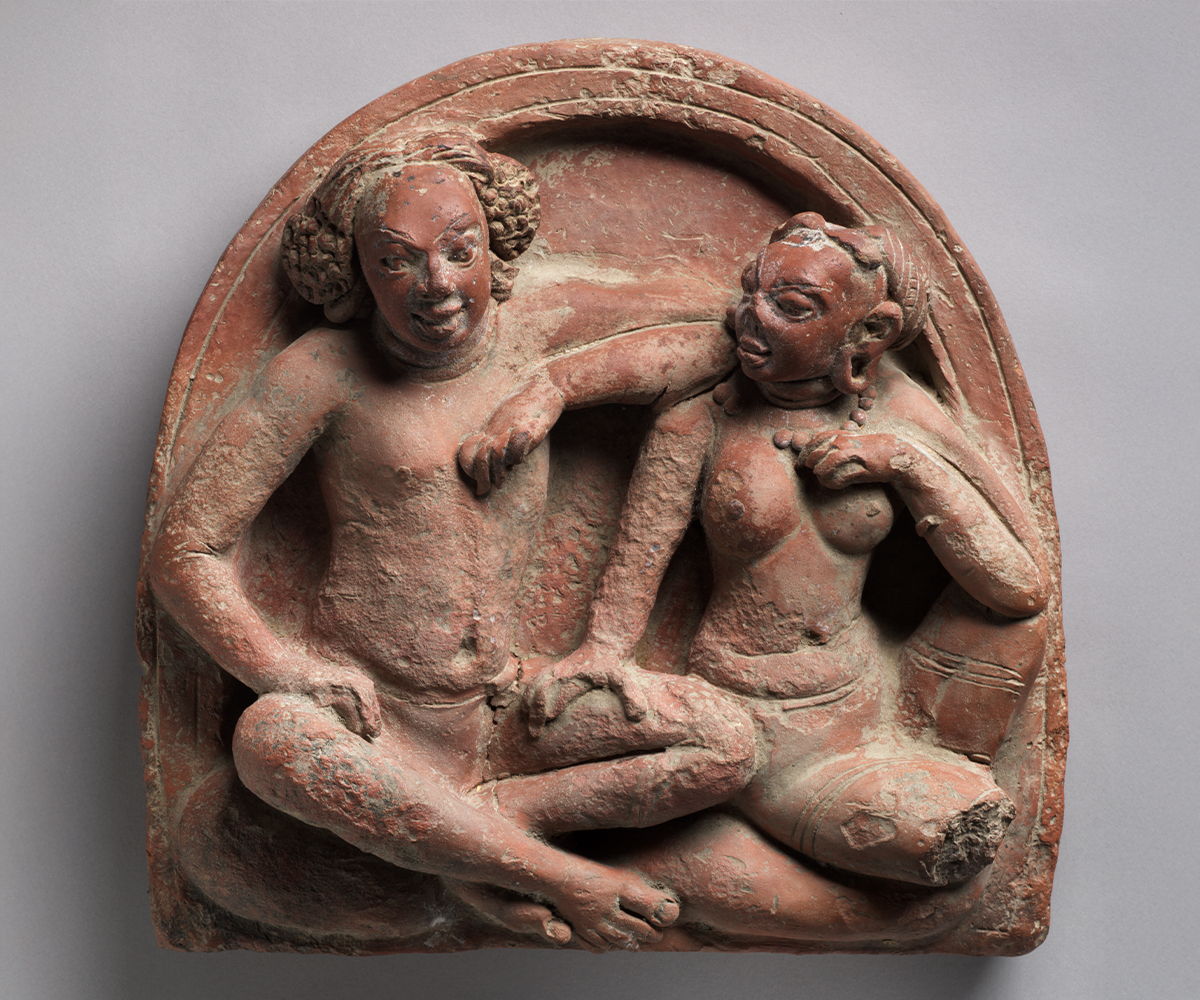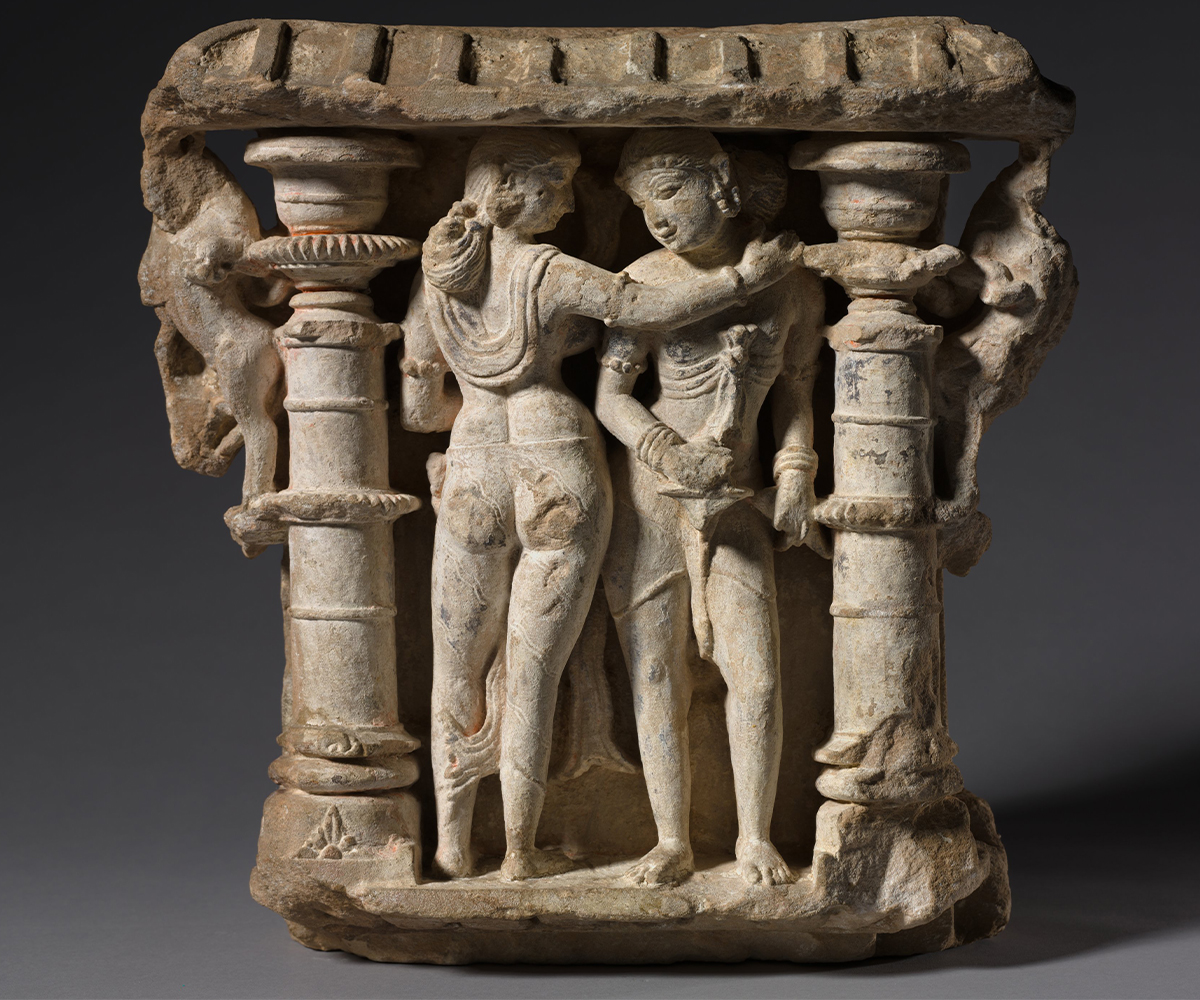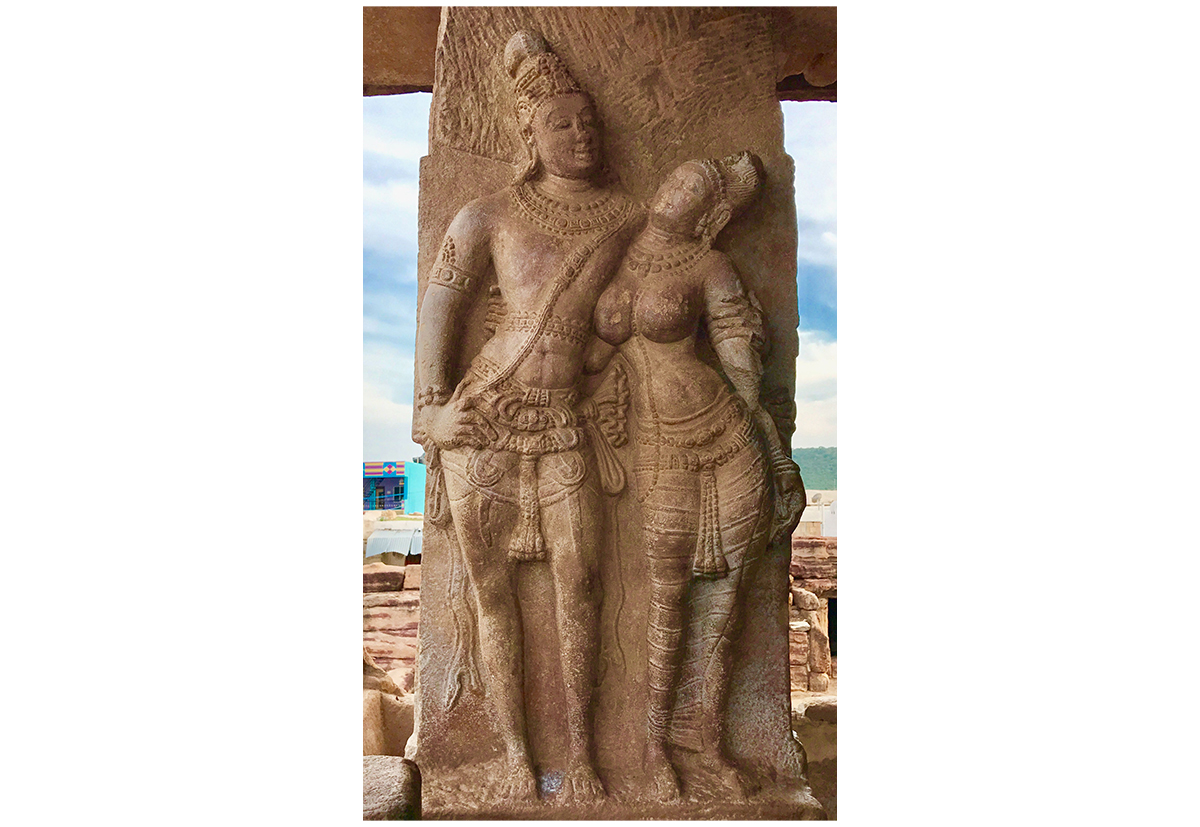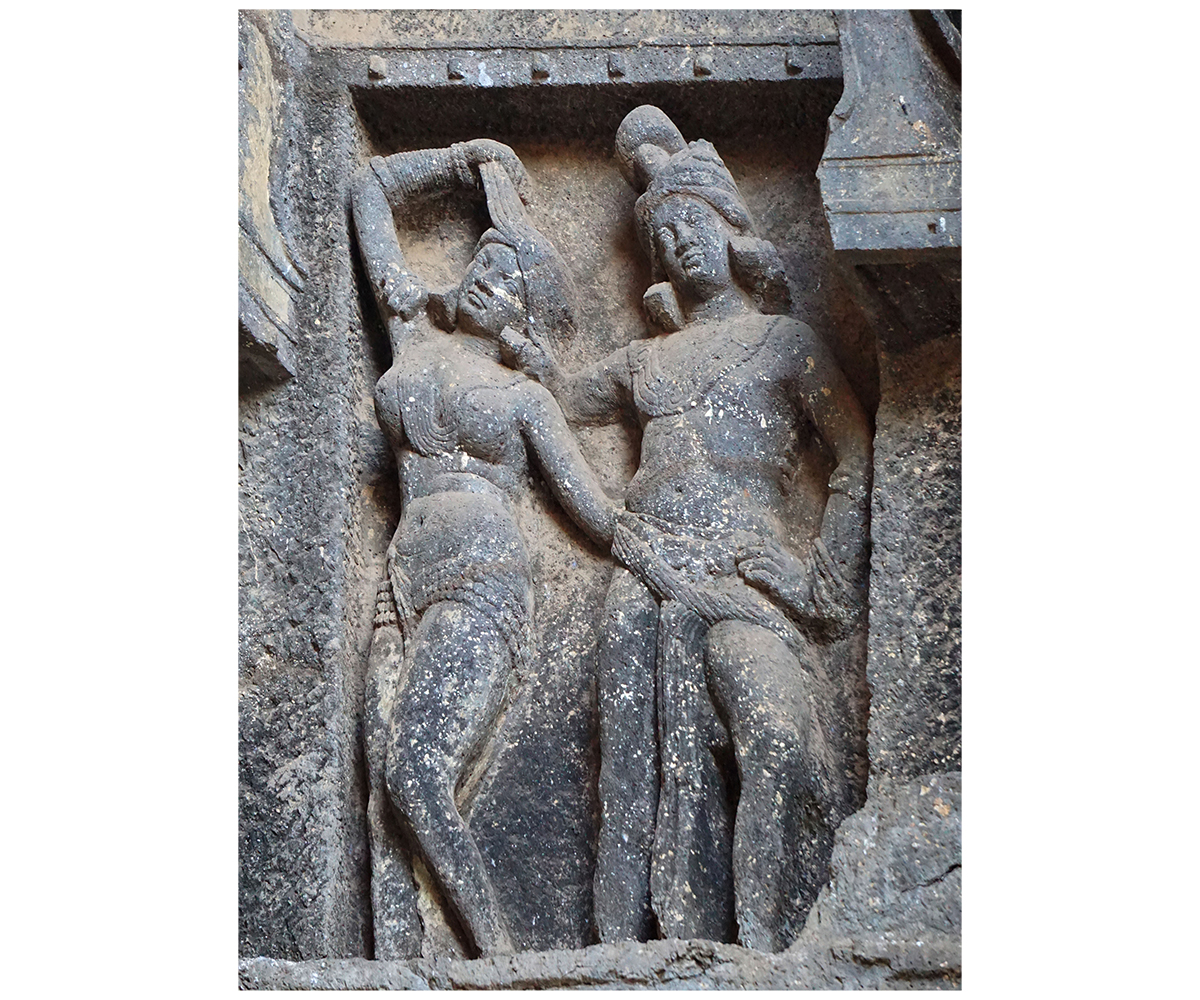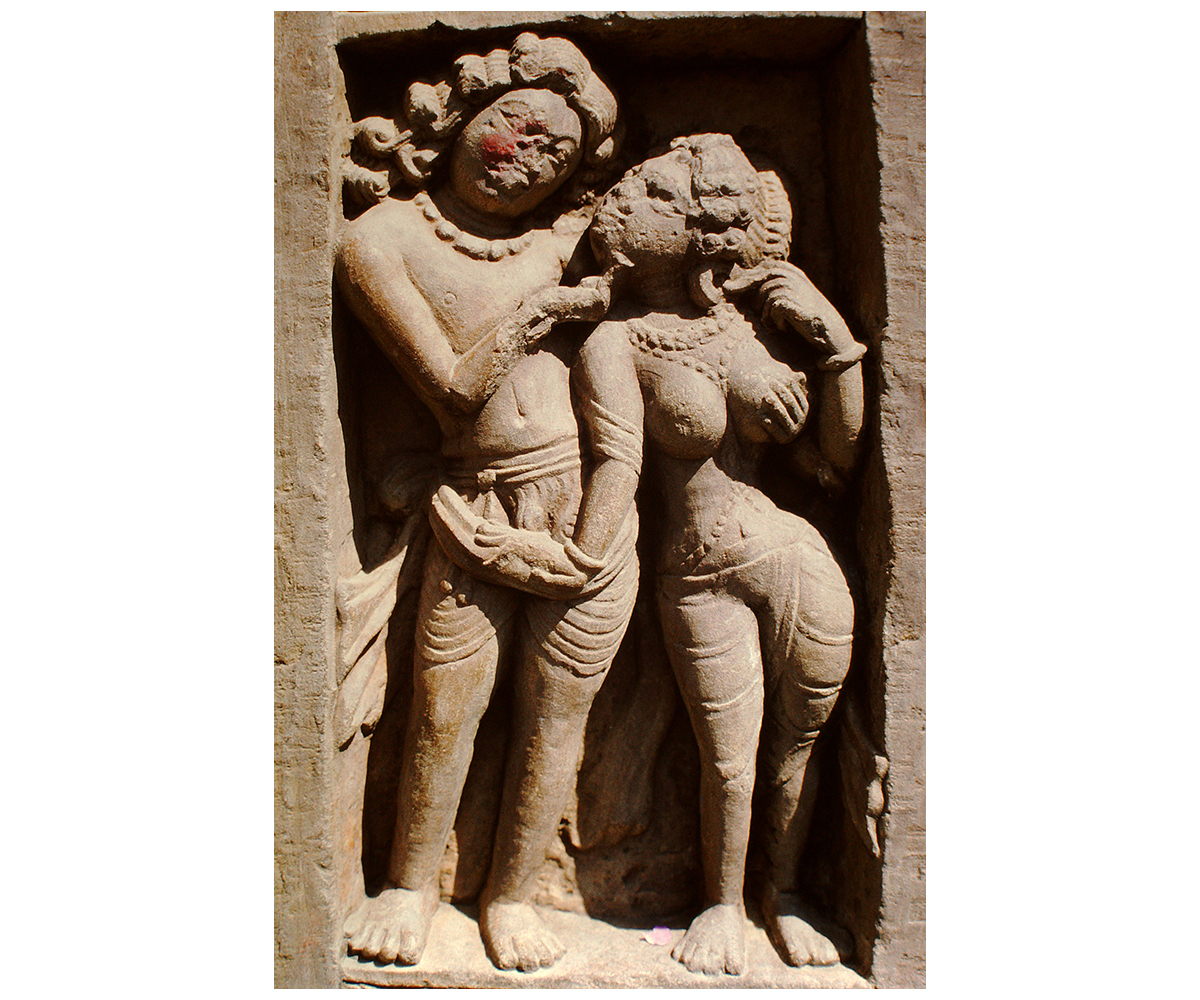ARTICLE
Mithuna
The concept of the mithuna evolved further as, much later, Buddhism and Jainism developed in the fifth century BCE and Vedic religion incorporated elements of folk religion towards Brahmanism. In the Buddhist scriptures and Jatakas, Jain sutras, and Brahmanical scriptures such as the Upanishads and epics such as the Ramayana, the mithuna or yugala motif became closely associated with a number of images and concepts borrowed from folk cults of fertility, including the Kalpavriksha, or Tree of Life, and Kamadhenu or the wish-fulfilling cow, and the concept of Uttarakuru, an idyllic realm of complete happiness and plenitude. These associations are reflected in the major sculptural depictions of the mithuna from the second century BCE onward.
The couple, or the act of sexual coupling, was a recurring allegory for spiritual attainment in several philosophical schools and religious sects that developed in the subcontinent from antiquity into the medieval period, accumulating shades of meaning that contributed to the depiction of the mithuna in art. Mithuna as union, pairing, or duality appears as an analogy for, variously, the blissful self-realisation or ananda of the Upanishads and Vedanta philosophy; the supreme joy or paramasukha of Tantric mysticism; the union of the spiritual male and female principles in Kashmir Shaivism or Samkhya dualism; the passionate, personal love for god in Bhakti cults, and so on. Of all these, Tantra was the most influential in the artistic depictions of the mithuna motif, given that the sexual metaphor was most explicit in Tantric thought, and that ritualised maithuna or sexual intercourse was a key feature of some heterodox Tantric cults.
General characteristics
Mithuna couples are not limited to human pairs; they include animals, hybrid human-animal beings, pairings of humans with animals (commonly, a monkey and a woman engaged in sexual activity), and pairs of semi-divine beings or celestial spirits, such as vidhyadharas, siddhas, gandharvas, yakshas and yakshis. The couple may be depicted standing, seated, or flying, and in various stages of intimacy — sometimes barely touching, or with the man placating the reluctant, bashful, or resentful woman; in a mutual embrace; undressing; or explicitly engaged in various sexual acts. The sexually engaged couple (maithuna) is often accompanied by female ‘helpers’ or attendants. The female figure may often be depicted with other symbols of sensuality or desire, such as the parrot on her shoulder. As a rule, her figure is rendered with conventional markers of youthful beauty, including full hips and breasts, and usually adorned with jewellery, elaborate coiffure, and so on. The mithuna is also often shown performing ritual worship or other activities, commonly drinking. Regional cultural influences led to variations in the execution of these general types; Gandharan relief sculptures, for example, bear strong resemblance to Roman bacchanalian sculptures — couples are shown drinking together, often with the woman turned with her back to the viewer, unlike the Indic convention of frontal view.
The mithuna of hybrid beings, though seen from the earliest specimens, proliferated especially after the sixth century CE; it appears widely in Western Chalukya temple architecture, as seen at the rock-cut Brahmanical temples at Badami and Aihole (c. sixth century CE) and the later freestanding temples at Pattadakal (seventh to eighth century CE). The thirteenth-century Surya temple at Konarak shows Naga couples with serpentine lower bodies and snake hoods. Other hybrid beings seen in mithuna sculptures include the horse-headed Assamukhi Yakshini, and kinnaras and kinnaris (winged centaurs). The jala-manusha (‘water-person’) mithuna shows human couples with their lower bodies rendered as waves of water. The Manasara text of the Shilpa Shastra corpus, dated between the fifth and eighth centuries CE, provides specific details on the form of these hybrid mithunas and their use in temple sculpture.
Early artistic representations
The mithuna, mostly as a human couple, features as an emblem on punch-marked coins minted from the eighth century BCE onwards by the various clans and kingdoms of the subcontinent. In the fourth and third centuries BCE, the motif appears on artefacts of folk cults of the mother goddess. On pre-Mauryan plaques from Rajgir and Kaushambi, and a Mauryan ringstone fragment from Rupar, nude couples are shown performing rites for a mother goddess, alongside other fertility symbols such as lotuses and varied animals. At times the goddess herself is depicted in a mithuna, paired with a priest or worshipper. In this period, a sub-type of the mithuna also appears, known as dampati — the married couple, with the woman on the man’s left. With the crystallisation of Shaktism, the Sanskritised cult of goddess worship, around the third or fourth century CE, the mithuna became especially prominent in Devi temples, often appearing in the place usually reserved for tutelary deities around the main sanctum.
In religious architecture
From the second century BCE, the mithuna motif appears as a recurring sculptural element in religious architecture, most prominently first in Buddhist monastic sites, and subsequently in Brahmanical temples. These early representations established the motif as a symbol of protection — most often found near the structure’s entranceway, along with allied motifs such as the tree or creeper, or the alasa-kanya (‘indolent maiden’, a nude woman usually with her genitals exposed). The Buddhist rock-cut caves in the Deccan region are the earliest examples of the mithuna motif appearing at or near entranceways; at Karle (second century BCE), Kondane (first century BCE) and Ellora (seventh to ninth centuries CE) mithuna couples are depicted on walls and the arches around windows. Cave 3 at Nasik (second century CE) features the earliest known doorframe compositions adorned with mithuna friezes.
At the Sanchi stupa (second century CE), mithuna figures are shown alongside pairs of cattle and lions; contemporaneous Bharhut reliefs include not only human couples as sacred symbols, but also pairs of birds on lotus flowers. Relief sculptures at Kushan-ruled Mathura (first to third centuries CE) feature animal pairs such as embracing hamsas (swans or geese), and the mina-mithuna or mina-yugala (paired fish), one of the Ashtamangala or eight auspicious symbols of Buddhism and Jainism. The couple appears alongside other sacred Buddhist symbols in the Amaravati stupa reliefs (first century BCE to third century CE), pillars and Jataka relief panels at Nagarjunakonda (third century CE), the murals and sculptures of the Ajanta Caves (late fifth century CE), and at the Mahabodhi Temple at Bodh Gaya (fifth to sixth centuries CE).
In the fifth century CE, the earliest sculptural depictions of the mithuna rashi or zodiac sign appear; a pillar capital from the Udayagiri Caves showing the twelve signs depicts a mithuna with the man holding a staff and the woman holding a veena. In the same period, the placement of the mithuna at the entrance to a temple became an established practice of Hindu temple architecture; in early Nagara temples built by the Guptas, the motif appears in the corners of door frames, as seen at Bhitargaon and Bhumara (fifth century CE), the Nachna Kuthara temples (fifth to sixth centuries CE) and the Dashavatara Temple at Deogarh (early sixth century CE). Subsequent temple styles followed suit, featuring the mithuna motif on a range of architectural features including mandapa pillars and capitals, ceiling brackets and medallions, niches, corners, mouldings, and multi-panelled lintel friezes.
Maithuna variant
From roughly the tenth century CE, a variant of the mithuna motif known as maithuna — which explicitly showed the couple engaged in sexual activity — began to proliferate mostly in the temples of central and eastern India, likely due to the growing popularity of Tantra and Shaktism in these regions. Though the distinction between mithuna and maithuna is at times blurry, the mithuna is generally characterised by the emphasis on the tenderness or grace of the couple, rarely depicting intercourse or other sexual acts, whereas the maithuna deals with a range of sexual activity. The maithuna in Hindu temple architecture is a rearticulation of the much earlier couple motifs of ancient goddess cults, which were often sexually explicit. Some of the earliest instances of the maithuna motif in temple architecture appear in early Kalinga temples in Odisha (c. seventh century CE). Even more elaborate and prolific are the sculptures at the Khajuraho Temples of Madhya Pradesh (eleventh to twelfth centuries) where erotic couples, often part of larger orgiastic scenes, are among the most widely depicted motifs on the temple exteriors.
Protective function
The use of the motif in Hindu temple architecture is explicated and described in various texts and treatises which have provided suggestions of its function; the earliest of these is the fifth-century Brihat Samhita, which places the mithuna alongside other protective symbols that appear on temple doorways, and emphasises its decorative function. The Jain epic Varangacharita describes a Jain shrine similarly decorated with mithunas and creepers. Passages from the Agni Purana elaborate on the protective function of the mithuna, claiming that it serves to protect the structure from evil, attackers, or natural calamities such as lightning or cyclones. Relatedly, the seventh-century writings of the Chinese monk and traveller Xuanzang describe mithunas in homes in Nepal that served to protect the structure.
Scholars have debated the mechanism by which the mithuna or maithuna functions as protection; some suggest that the beauty or charm of the image is the key to its auspiciousness, and others propose that its obscenity works to ward off evil. However, the ubiquity of the image — often appearing even in the absence of other symbols — seems to underline its significant positive spiritual value in traditions across regions and religious sects.
Bibliography
Agrawala, Prithvi K. Mithuna: The Male-Female Symbol in Indian Art and Thought. New Delhi: Munshiram Manoharlal, 1983.
Bhattacharyya, Dipak Chandra. “Erotic and Genre Themes.” In Indian Subcontinent. Grove Art: 2003.
Cummings, Cathleen Ann. A Study of the Iconographic Program of the Lokesvara (Virupaksa) Temple, Pattadakal. PhD Dissertation. Columbus, USA: Ohio State University, 2006.
Donaldson, Thomas. “Propitious-Apotropaic Eroticism in the Art of Orissa.” Artibus Asiae 37, no. 1/2 (1975): 75–100. https://doi.org/10.2307/3250213.
Huang, Michelle Ying Ling. Beyond Boundaries: East and West Cross-Cultural Encounters. Newcastle Upon Tyne: Cambridge Scholars, 2011.
The Metropolitan Museum of Art. “Ayaka Cornice with Four Narrative Roundels.” Accessed November 18, 2024. https://www.metmuseum.org/art/collection/search/761985.
The Metropolitan Museum of Art. “Loving Couple (Mithuna).” Accessed November 14, 2024. https://www.metmuseum.org/art/collection/search/38141.
The Metropolitan Museum of Art. “Two Box Panels with Mithuna Couples.” Accessed November 14, 2024. https://www.metmuseum.org/art/collection/search/78873.
The Philadelphia Museum of Art. “Erotic Couple (Mithuna).” Accessed November 14, 2024. https://philamuseum.org/collection/object/56708.
